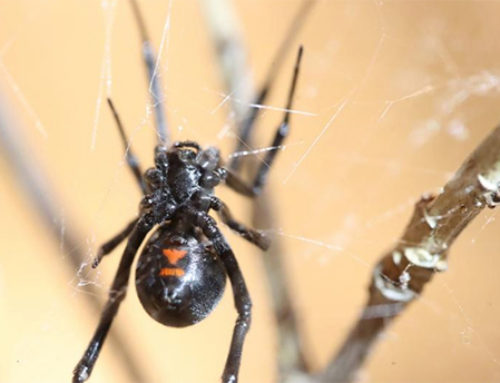Did you know that there are around 621 different species of spiders in Utah? Additionally, most all types of spider possess venom. Yikes!
There are 7 specific types of spiders in Utah, which are known to be the most common and dangerous. These species include Black Widow, Brown Recluse / Desert Recluse, Hobo spider, Wolf spider, Yellow Sac, and the Huntsman spider.
That being said, now is the time for you to learn about these common Utah pests. Below, we’ve listed the most prevalent spiders in Utah and steps to prevent or exterminate a spider infestation.
Black Widow
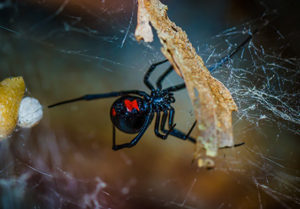
The Black Widow spider can be found all throughout North America. This species is a surprisingly common one amongst other spiders in Utah.
Characteristics
When the female Black Widow spider matures, it features a black and shiny coat, with a distinctive red hourglass mark along the underside of the abdomen. It is at this stage where female Black Widow spiders get their signature look. Before maturity, Black Widows can appear lighter, or duller in color. Male Black Widow spiders may lack the signature red marking.
Where can you find Black Widow spiders in Utah?
Black Widows usually reside in undisturbed areas with little to no activity going on around them. These areas include, but are not limited to, piles of wood, rocks, on or inside fences, crevices of buildings or homes and often nestle where debris has settled. It is important to realize that this species is classified as one of the most dangerous spiders in Utah.
Black Widow spider bite
A bite from a Black Widow spider will leave you with two small holes on the surface of the skin where the spiders fangs have pierced through. Spiders will sometimes “dry bite” in self defense, meaning no venom was released in the bite. A spider will dry bite if they feel threatened, but do not want to waste their venom. If you are bit by a Black Widow, you may experience nothing but a little pain and swelling. That being said, every individual will have their own reaction to spider venom. In some cases, this reaction can be severe or even life threatening. Symptoms usually appear within 20 to 30 minutes, and include vomiting, high blood pressure, muscle spasms or cramps, confusion, shock or worse.
Intermountain Health Care offers the following tips for what to do in the instance of a Black Widow spider bite:
- Get medical help immediately. Call your doctor, hospital, or poison control center. The number for Utah Poison Control is 1-800-222-1222.
- Remain calm. Too much excitement or movement will increase the flow of venom into the blood.
- Apply ice to the bite area.
- Do not apply a tourniquet. It may cause more harm than benefit.
- Try to positively identify the spider or catch it to confirm its type.
Desert Recluse / Brown Recluse
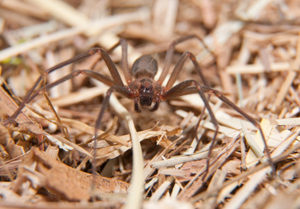
Characteristics
Brown recluse spiders typically range between 6 and 20 millimetres (0.24 and 0.79 in) in length, but may grow larger. These spiders are usually light to medium brown, although they can range in color from white to blackish gray. The Brown Recluse spider has a distinctive marking along its back, as well as its neck. This marking is often said to resemble the shape of a violin.
Where can you find Brown Recluse spiders in Utah?
The Brown Recluse spider can be found all across Utah, although this species is more common in Southern Utah. It’s important to realize that this spider prefers bone-dry areas with a lot of heat. The Brown Recluse thrives in desert habitats.
Brown Recluse spider bite
If you are bitten by a Brown Recluse spider, apply ice to the affected area, compress, and elevate the wound. First Aid Experts suggest to keep close watch of the bite, and seek medical attention as soon as possible if you develop a boil or ulcer. A bite from any Recluse spider species comes with the possibility of contracting skin infections or lesions.
Hobo Spider
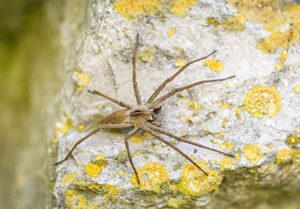
Hobo Spiders are common in Utah, in addition to the Pacific Northwestern United States.
Characteristics
The Hobo spider is widely known as one of the hardest spiders to identify. That said, there are some unique characteristics to this spider, which we will include. This spider has an abdomen with chevron (or V-shaped patterns) down the middle, with the V-shapes pointing towards the head. Hobo spiders also have a light stripe which runs down the middle of their chest. Hobo spiders are typically light tan to light brown in color, but can also be darker brown.
Where can you find Hobo spiders in Utah?
Hobo Spiders were first discovered in Utah in the 1990s. The Hobo Spider is an extremely fast runner, with the ability to dodge many of its predators. That said, Hobo Spiders are not good climbers and usually build their webs close to the ground. Hobos live in small holes or crevices where they will strategically build funnel-shaped webs.
Hobo spider bite
A Hobo Spider bite can result in necrosis, where the skin around the area of the bite begins to die. Although the Hobo is classified as a dangerous spider, there are very few documented cases of severe bites. As previously stated, this spider is incredibly fast. Victims of a Hobo Spider bite rarely see or catch the spider once the bite occurs.
Utah State University offers the following information about Hobo Spider bites:
- The severity of envenomation depends partly on the amount of venom injected, as well as the sex and age of the spider. The bite of the hobo spider is relatively painless and is reported to feel like a pinprick.
- Within 15 minutes of the bite, numbing sensations may occur at the bite site or other areas of the body (such as the tongue), and dizziness may occur.
- After about 1 hour, reddening around the bite begins and enlarges in the area. The bite site becomes hardened and swollen within about 18 hours. Blistering at the bite site, severe headache, visual or auditory disturbances, weakness, and joint pains may occur within the first 36 hours.
- Within 24 to 36 hours, a discharge of fluids and blistering may occur, and after 2 or 3 days the area around the wound may blacken. A cycle of sloughing and crusting at the ulcerated site may continue for some time, often requiring six months or more for complete healing to occur.
Wolf Spider (Lycosidae)
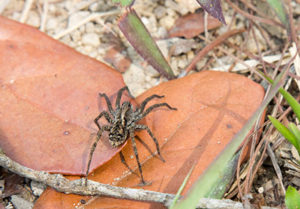
The Wolf spider is extremely common in the United States, especially in Utah.
Characteristics
Scientists have identified more than 120 species of Wolf spider in the U.S. alone. Many fear at the sight of a Wolf spider due to its large stature (some species grow up to 2 inches in length), but the Wolf spider bite isn’t always harmful. On the contrary, Wolf spiders are currently classified as one of the most dangerous spiders in Utah, as well as in the World. Like wolves, these spiders are hunters. That is where Wolf spiders get their trademark name. Wolf Spiders are articulate, as they stalk and ambush their prey by pouncing for the kill.
Where can you find Wolf spiders in Utah?
You are most likely to encounter a Wolf spider on the ground in open areas, like farm land or grassy areas. Some characteristics of Wolf spiders include an orange-brown to gray and sometimes black complexion that is hairy in texture. Covered in splotchy-stripes help the Wolf Spider camouflage from predators. Mother Wolf spiders are often seen with the offspring riding on their backs until these young spiders are strong enough to go off on their own.
Wolf spider bite
Although Wolf spiders are considered one of the most dangerous species of spider, their bite is not leithal. That being said, a bite from a Wolf spider can be very painful. Additionally, some people may allergic to the bite of this spider. If you suspect that you’ve been bitten by a Wolf spider, always seek medical attention and treatment by a doctor.
Yellow Sac Spider (Tegenaria agrestis)
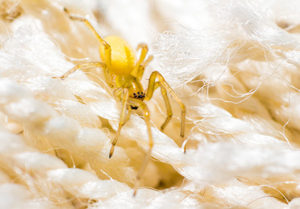
Most Utahn’s are unaware of how common the Yellow Sac spider is in this state.
Characteristics
Some characteristics of the Yellow Sac Spider include an average length of 6mm (which is about the size of a nickel). This spider is named after their bright yellow, opaque-like coloring. Yellow Sacs have no distinctive markings, other than a brownish tint to their eyes and mouth. The first two legs are significantly longer than the others. Male Yellow Sac spiders are smaller in stature when compared to the females.
Where can you find Yellow Sac spiders in Utah?
Yellow Sac spiders are nocturnal creatures, so you are more likely to catch a glimpse of one when the sun is down. During the day, Yellow Sac spiders spin a flat silk sac and reside there until the next evening comes. These spiders are known to sneak their way into houses, and will loiter along baseboards, the corners of walls and ceilings.
Yellow Sac spider bite
The Yellow Sac spider bite can cause a lot of pain and discomfort. According to a paper published in 2006 titled, “Verified bites by Yellow Sac spiders (genus Cheiracanthium) in the United States and Australia: where is the necrosis?”, covered 20 cases of spider bites by Yellow Sac spiders in the U.S. and Australia, and found that in all instances, people experienced pain or discomfort. The reported median pain length experienced by the affected victims lasted for about 1 hour and 45 minutes. One person dealt with a headache and someone else experienced nausea and vomiting. Given these points, it’s important to realize that the Yellow Sac spider is one of the most poisonous spiders in Utah.
If you suspect that you’ve been bitten by a Yellow Sac spider, expect pain including redness, burning, swelling and itching. Doctors suggest applying hydrogen peroxide to the bite and surrounding area, then apply ice. If you experience nausea, vomiting or persistent headaches, immediately visit a doctor.
Camel Spider
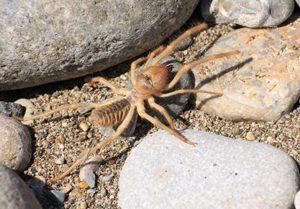
Big, hairy, and scary looking is best way to describe the characteristics of the Camel spider.
Characteristics
Camel spiders can reach up to 6 inches in length, and weigh about 2 ounces. These spiders have adapted well to desert living, making it the perfect habitat for these spiders in Utah Due to their unique way of breathing, these spiders can run up to 10 miles per hour.
Where can you find Camel spiders in Utah?
Camel spiders are typically found under rocks or any shelter from the sun, in dry and hot areas. Some species of Camel spider can hiss, and will use this as a defense mechanism towards predators. While these spiders are undoubtedly large, they do not have a deadly bite.
Camel spider bite
If you have been bitten by this creature, you can rest easy knowing that the Camel spider bite is not poisonous. However, a Camel spider bite will likely leave you with a nasty-looking wound. If you can identify that it was in fact a Camel spider that bit you, and you are experiencing intense pain, swelling or bleeding, visit a doctor right away. There are many cases of Camel spider bites that have caused flesh eating infections.
Huntsman spider (Golden Huntsman)
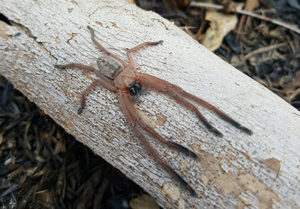
The Huntsman spider belongs to the giant crab spider species.
Characteristics
These spiders are typically light tan to brown in color, with darker areas around the eyes and tips of their legs. The Huntsman spider slightly resembles a crab, with pinchers as front legs.
Where can you find Huntsman spiders in Utah?
Huntsman spiders are found in Southern Utah, and tend to be located in warmer states across the U.S. Usually found in arid areas of shrubbery and rocks, or on the ground. Equally important, the Huntsman spider is an amazing climber with the added ability to crawl across ceilings. Though large in size, Huntsman spiders are typically no threat to humans.
Huntsman spider bite
If you think you may have been bitten by a Huntsman spider, clean the affected area with hydrogen peroxide, apply ice and compression. If you have any severe side effects, such as vomiting, excessive bleeding, headaches or anything of the sort, seek medical attention right away.


